
If you’re having trouble wrapping your mind around the fact that it’s the end of 2019, welcome to the club.
This year flew by, and in the marketing world a lot happened. Conversational marketing, the takeover of chat bots, and never-ending changes to algorithms rocked our digital marketing loving world.
And it was a blast.
As the year comes to an end, it’s tradition for us to show you the marketing home runs of other digital marketers so that you can apply their tactics to your strategies.
So, without further a do, here are 13 marketing home runs of 2019 from some of our favorite digital marketing experts.
Michelle Barnum Smith, AMZ Messenger Bot Club

Winning on Amazon for private sellers becomes harder and harder every day. This year, chat marketing gave marketers the opportunity to run product launches and help sellers rank their listings, follow up, and request reviews. This leveled the playing field and gave private sellers a bigger chance of succeeding.
This last year I helped over 1,000 Amazon sellers launch their products. These high-quality product sellers were able to get ahead of their competition and win the algorithm game against Amazon.

Here’s a simple example:
- Setup a ManyChat flow that distributes 75% off single use coupon codes
- Connect the flow to Facebook ads
- Send subscribers on a “Treasure Hunt” to find the new product in Amazon search results (typically called a Search, Find, Buy campaign)—this mimics organic search behavior and results in higher ranking from those purchases
- Pro Tip: If you have a warm responsive list, instead of coupon offers, send them a rebate offer—full price purchases result in the best possible ranking benefit and you can request reviews from full price buyers
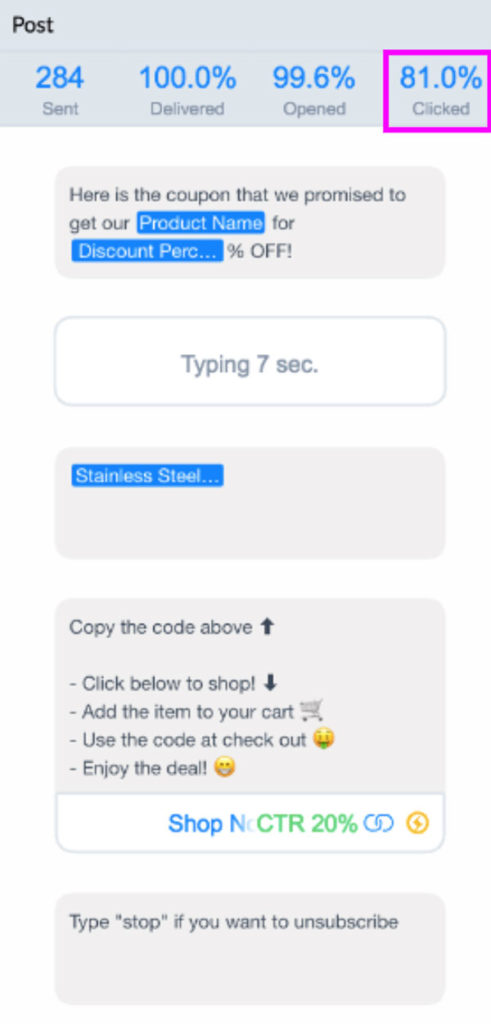
Chat Marketing through ManyChat makes automating this whole experience easy for the sellers and the subscribers!
Tara Robertson, Director of Customer Marketing at Sprout Social

One of the most successful digital marketing campaigns we ran this year was our annual data report, the Sprout Social Index. The Index aimed to better understand consumer motivations, social trends and how marketers are approaching social as a whole. This report is one of our primary awareness and lead generation efforts for the entire year and not only were we recognized as a finalist for Brandweek’s Constellation Awards, but we saw great success from our distribution methods that leveraged Facebook lead generation ads, community promotion and networking with our co-marketing partners.
In addition to the 2019 Index, our team held our largest digital customer event of the year, the Sprout Agency Workshop: Rise and Grind. We connected agency customers across the globe to share tactical advice on how they can be more efficient and effective in their roles. The event was a massive success with over 1,300 customers who tuned in to discuss their unique opportunities, challenges and how they overcame them. This was a great way for us to not only build product training and customer engagement into the marketing mix but also find new ways to connect our agency community with one another to further their learning and growth.
Logan Fletcher, Content Marketing Manager

Testing and building a strong LinkedIn marketing strategy was a very scalable home run for our agency; not only has it 4x our website traffic, and doubled our sales funnel, but it’s a strategy that we’ve been able to roll out to clients to improve their online presence and drive revenue as well.
Here’s what it entails (at a high-level): creating engaging videos that resonate with our audience, regularly posting value-adding content and articles, using account-based marketing to send targeted messages, adding quality connections, engaging with the LinkedIn community on posts and groups, and more.
Benton Crane, CEO of Harmon Brothers

Our marketing “Home Run” of 2019 was this origin story campaign for Lumē.
It combines a heartfelt origin story with all of the direct-response sales elements that make all Harmon Brothers’ campaigns successful.
Our previous campaign had already helped Lume 10x the company from $1.5M/yr to $15M/yr. The launch of the origin-story campaign helped them more than 2x again ($30+M/yr).
Nathalie Lussier, Founder of AccessAlly

As Jay Abraham famously explained it, there are 3 main ways to make more money in your business:
- Increase the number of clients
- Increase the average transaction
- Increase the frequency that the average client buys from you
As a small software company, we already offer a recurring monthly plan so we knew the frequency wasn’t going to change.
We’re always marketing to increase the number of clients we have and implementing ways to improve our retention rates.
So in 2019 we decided to increase our prices. We didn’t decide to raise prices willy nilly though.
We did our research and we knew that our software was able to save our clients hundreds of dollars per month, because we had added so much functionality over the last 5 years.
In years past, we had a tendency to over-engineer our marketing campaigns and spend months creating pre-launch videos, designing beautiful Facebook ad graphics, enlisting our affiliates, and writing tons of emails.
This time, we had a deadline (I was about to have a baby!) so we kept the campaign simple with:
- A series of 4 emails to our warm leads
- A series of 4 emails to our affiliates
- 2 emails to our existing clients
- 4 retargeting FB ads to anyone who had been to our website or on our email list in the past 90 days
- A small “price increase notification” bar at the top of our site
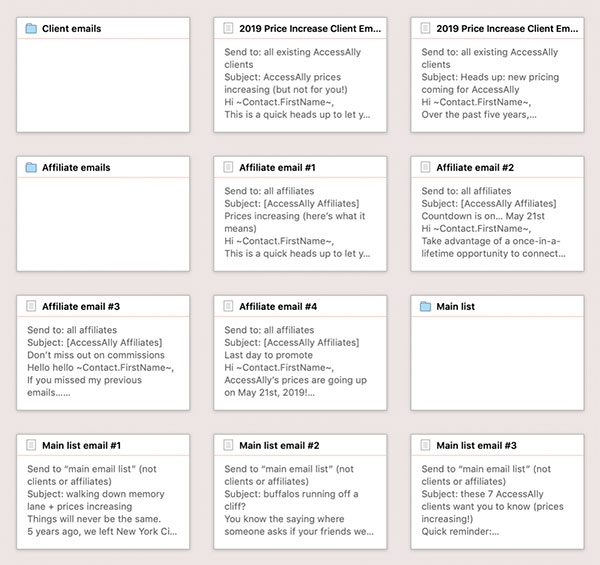
The price increase took place over 20 days, so we had a chance to book live demos and answer people’s questions before they signed up.
Thanks to this price increase campaign, we had an 8% increase in clients in the month of May (compared to our usual 2-3% growth per month). But most importantly, it helped us retain clients too.

The way we structured the price increase meant that existing clients (and anyone who signed up before the deadline) got to keep their pricing indefinitely. That “locked in” price has kept our existing clients from canceling if they knew they wanted to come back later.
We were expecting to have a lot of refunds from folks who just wanted to check us out in case they liked the tool while the price was lower… and we did have a few, but not nearly as many as we imagined.
In the end, we raised our prices from $79/month to $99/month for our essentials plan and we added over $200,000 in annual recurring revenue to our business.
It was also one of our easiest marketing campaigns, where we spent less than $1500 on Facebook ads, and really focused on the existing people on our email list who were on the fence.
Jody Milward, Founder of Social Charlie

In the Coaching and Digital product niche, we’ve seen strategic Facebook Ad retargeting campaigns increase the number of leads by 244% compared to more traditional campaigns that would retarget leads or webinar registrations for a week or 2 after the initial conversions.
By combining ‘pre-targeting’ strategies where we promote a video magnet, a content magnet, a read magnet and a lead magnet, we’re building a larger audience of our ideal clients than if we were to just focus on instant opt-ins.
Then, our retargeting campaigns are made up of 3 layers designed to nurture, convert and close our prospects—so they are, in fact, progressing through a customer journey in their Facebook newsfeed.
These campaigns will retarget the the audience over a 90 day (or longer) timeframe with content that builds awareness, authority and affinity so that when they are ready to buy or book a call, you’re the obvious choice.
This is where we see 3x the amount of leads picked up versus a short 21 day retargeting window. And when someone has been watching you in their newsfeed for 3 months and they go to your sales page or book a call…they are ready to buy.
(NOTE: Need a helping hand with your digital marketing efforts? Or maybe you just want proven, actionable marketing tools, tactics, and templates to implement in your business? Check out the latest deal from DigitalMarketer, and you will be on your way to helping your business grow.)
Ash Roy, CEO and Founder of Productive Insights

The biggest digital marketing home runs came from conversations with my customers. I got on face-to-face calls with them and got a good understanding of their business using a specific diagnostic framework where we worked together to get a deep understanding of:
IDEAL CUSTOMER AVATAR: We understood the demographic and psychographic profiles of their ideal customer.
EMPATHY MAPPING: We got clarity around what their customer was thinking, feeling, seeing, hearing and doing; before purchasing the product, while they were purchasing the product and after they’d completed the purchase. This gave us a good insight into the transformation the customer experienced — from the customer’s standpoint—that told us how to deliver an even better experience to the customer.
CURRENT CUSTOMER ACQUISITION STRATEGY: We looked at what was working right now and what wasn’t working, so we could double down on what was working and then work on improving what wasn’t working.
KEY METRICS: Understanding the customer lifetime value, cost per lead, conversion rate from lead to customer which gave us the customer acquisition cost.
CUSTOMER PROBLEM DEFINITION: Getting clarity on the customer problem statement and, more importantly, the unstated problem of the customer was very powerful in developing a deep insight into how we could help the customer .
PRODUCT STRATEGY: Looking at the current offers and future offers and how we could layer those offers to create complementary products helped us increase “stickiness”.
Shannon Goodell, Social Media Manager at DigitalMarketer

One of our big home runs on DigitalMarketer’s social media marketing side was one of the simplest to execute: “Mini Marketing Whiteboard Workshop” videos.
Two things happened that set this initiative in motion:
- Decrease in organic views and engagements for our AMA series (“Ask Me Anything” videos)
- Facebook pivoting to longer-form videos.
We also wanted to test how less produced videos would perform— simple, landscape videos with no fancy graphics or banners at the top or bottom. We decided to give it a try and start with 2 of our core teachings: The Before and After Grid and the Customer Value Journey.
Of course, for these 2 we had to get THE Ryan Deiss in front of the camera. He’s the expert and has an incredible camera presence. I thought the filming went well, but I was worried about the length. One of the videos clocked in at 17 minutes. But, they performed!
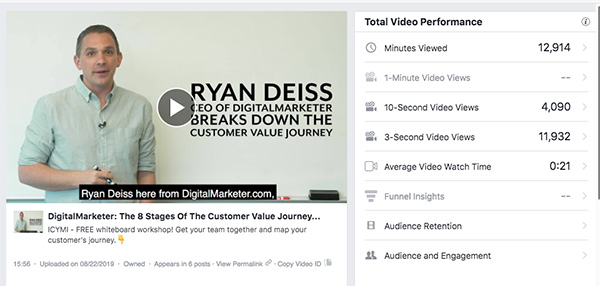
People were interested, because they were learning something super valuable and ACTIONABLE. They could use the video to work with their teams on mapping out the Customer Value Journey or filling out the Before and After Grid.
We’ve since filmed more whiteboards with both internal team members and external team members, like Chris Mercer and Natasha Takahashi, and they’ve all been various lengths (but all over 3 minutes).
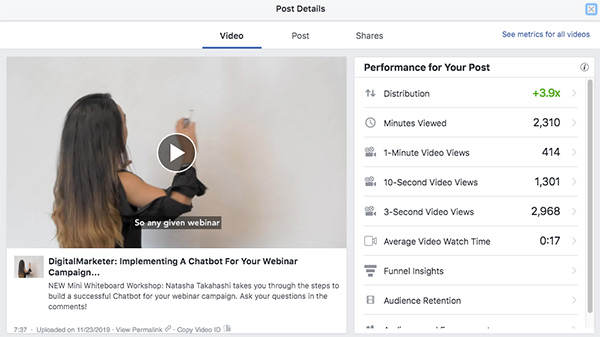
They’ve consistently performed well both on Facebook and IGTV. Our audience is really finding value in such a simple approach: Getting an expert in front of a whiteboard with a marker and saying, “GO!”
Due to the success of the whiteboards on organic social, we are now trying them on paid social. This just reconfirms that organic social matters, so be willing to try something a little outside-of-the-box.
Don’t get bogged down worrying about suggested video times or a lack of a video budget. Get in front of the camera and teach; your audience just may love it.
Sherry Bonelli, Owner of Early Bird Digital Marketing

One of the most effective digital marketing strategies for local businesses in 2019 was claiming and optimizing Google My Business (GMB) profiles. Google offers qualified local businesses the opportunity to get a FREE listing that increases the likelihood of their business showing up in Google’s “Local 3-Pack” when people search on Google:

Results can be dramatic – and fast! Within the first month, one of my clients said she noticed a dramatic increase in the number of calls her small business loan company was receiving. So much so that she wanted my agency to start optimizing Google My Business profiles for three other locations they had around the state of California.
For a local business, website visits, calls and customers visiting their storefront mean REAL money to that business. With Google My Business Insights, you can track by week, month or quarter the engagement your Google My Business Knowledge Panel is getting – allowing you to see direct results of your profile’s performance (and how it’s helping grow your business!)

Every business that qualifies for a GMB profile should claim their listing and optimize it on an ongoing basis to stay ahead of their competition. It can help them rank in the top spots on Google and get more customers. If they don’t, they’re missing a HUGE opportunity!
Josh Turner, Founder & CEO of LinkedSelling

Being everywhere we could be.
Our goal for 2019 was to not overly rely on one ad placement, one strategy, or one platform. Let’s look at one platform specifically, LinkedIn ads.
We’ve seen over the past few years that Sponsored Content ads (placed in the LinkedIn Newsfeed) generate the bulk of our lead generation. They also receive our highest click-through rate, engagement, and reach.
But the word is out on that.
Increasingly over the past 6-8 months bigger players have gotten hip to the opportunity with LinkedIn ads and it has become a more competitive landscape.
To stand out we incorporated campaigns in a multitude of other placements that LinkedIn offers (Dynamic ads, Text ads, Sponsored InMail) and asked ourselves how can we meet our prospects on the level they are most inclined to respond to. We found some great cost savings by targeting our audience in more than one placement at a time.
Now, it’s not a new idea to try and show up on as many channels to your prospects as possible.
But in these days of big data and real-time optimization, we’ve found that the more we show up in front of our audience (even if every individual placement or marketing channel isn’t getting top return), the better our overall return on ad spend has become.
So our big home run for the year was simply meeting our audience on as many channels as we could. It’s what allowed us to increase our qualified appointments booked by 63% while maintaining the same overall ad budget.
Eva Gutierrez, Freelance Content Writer

My major home run in 2019 was something quite often overlooked—testimonies from my client’s customers about how much they loved the content we were creating.
Content strategies can be difficult because when you’re in the Awareness stage of the Customer Value Journey, you can’t always track exactly what impact your content is having. You’re so early in a prospect’s journey to becoming a customer, that subscriptions and product purchases are still a few weeks away.
Whenever a clients’ customers are giving us feedback like that, that’s when we know that we created 1) the right content, 2) delivered it in the right way, and 3) said it in the right voice.
That trifecta is what makes content work or flop. The DigitalMarketer Customer Avatar Worksheet is always the starting point for figuring out what content I’m going to create. It’s where you turn your customers pain points and challenges into helpful content that makes them think, “Wait, who wrote this?”.
Once you know what topics you’re going to create content on, you figure out how your customers want their content (quick blog posts, long blog posts, weekly newsletter’s like the DM Insider, etc.).
And lastly, it’s how you figure out who they want to be telling them this information and hone in on your brand voice. I use spectrums that toggle between playful and authoritative, friendly and mature, and for the masses or for a niche to figure out what that voice sounds like.
Ralph Burns, Founder of Tier 11
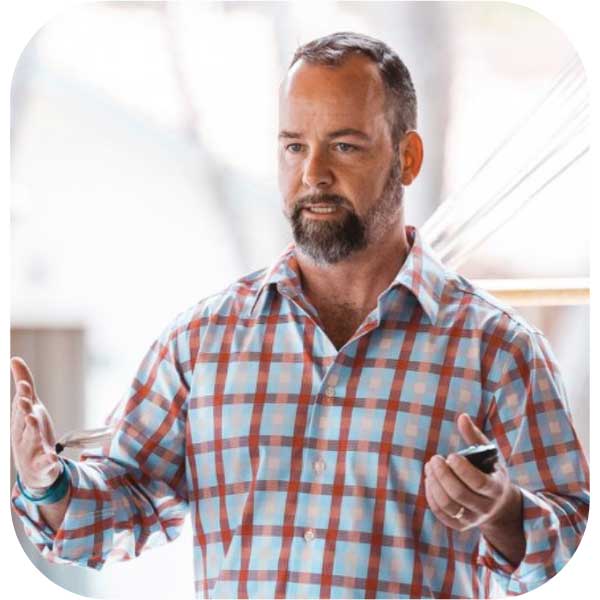
Have you ever been in this situation?
You’re running Facebook ads. You have an ad set that, overall, is performing well. But when you look INSIDE the ad set, you notice a discrepancy.A couple ads seem to be doing most of the work and generating a ton of conversions…while other ads appear to be underperforming.
So being the smart marketer you are, you decide to go in and pause all the poor-performing ads. You logically assume that if you pause the bad ads, then overall performance of the ad set should improve.
So you do it…and suddenly the overall performance of the ad set goes DOWN!
It doesn’t make sense, but for some reason your conversions start to go south. And you’re left scratching your head, wondering: What in the heck just happened?
If this sounds familiar, don’t feel bad. At Tier 11, we live and breathe Facebook & Instagram ads. But we’ve still experienced this strange phenomenon and been puzzled by it.
But in 2019, we made a major breakthrough that has helped us to avoid this problem, while revolutionizing the way we structure our Facebook ad sets.
We call it “ad grouping.”
In a nutshell, we discovered that we get better performance by creating a GROUP of ads that work together synergistically, rather than just trying to create one great ad.
Why Ad Grouping Works
The reason this strategy works so well is because, at the end of the day, your ads don’t live in a vacuum. Instead, multiple ads can reinforce one another. They can work together.
This is why pausing your “poor-performing” ads can cause your ad set performance to tank—because even though those ads weren’t directly responsible for generating conversions, they may have indirectly helped drive people to convert on your other ads.
And here’s another thing to think about:
Different people respond to different hooks, and engage differently with different ad types.
Some people prefer videos. Other people might have videos turned off entirely (especially when they’re not on wifi). Still other people are more likely to respond to carousel ads.
To appeal to all these different segments, you’ll need different ad types and hooks inside each ad set.
How to Leverage Ad Grouping in 3 Easy Steps
So how do you actually DO it? Here are a few quick rules of thumb:
1) Make sure each ad set contains at least 1 image ad and 1 video ad
This is the absolute minimum requirement. You should ALWAYS have at least 1 image ad and 1 video ad running in every single ad set.
2) We also highly recommend at least 1 carousel ad
Carousel ads aren’t quite as critical as image & video ads, but they’re still pretty darn effective. So we recommend having at least 1 video ad, 1 image ad, and 1 carousel ad in each ad set.
3) Include 2 “control” ads and 2-6 “test” ads
Overall, we like to shoot for 4-8 ads per ad set. Two of those ads should be “control” ads—in other words, ads that we know to be effective from previous data.
The other 2-6 ads should be newer ads. We like to test different ad formats and different hooks, too.
Don’t Overcomplicate It
And that’s about it, guys. It doesn’t have to be super complicated. Just follow these 3 steps and you’ll help protect your ad sets from the declining performance that comes from one-ad-itis.
Because we work with some very large advertisers, we often have large ad sets (6-8 million or more). We’re finding that Facebook has gotten better and better at picking out the smaller groups within a bigger audience that will respond to your ad—which means you can use a fairly broad audience and still get great results.
Just remember that if you’re targeting an audience of 8 million people, not all of those people are going to respond to the same ad type or messaging! And that’s where the ad grouping strategy can really shine in helping you to wring the maximum conversions out of your ad sets.
Mike Rhodes, CEO of WebSavvy

AI & Machine Learning are here. But… they’re far from perfect at this stage. Google is arguably the world leader in ML but even they, with all their data & blindingly fast computers don’t get it right every time. One day maybe they will, but we’re not there yet.
Which is why we’ve spent a lot of 2019 at my agency, WebSavvy, improving our systems to monitor the AI. We want to know – with hard data – where it’s strong & where it’s weak. So we can add smart people to the mix in the right places & work with the Machines to get outstanding results for clients.
I’ll outline a handful of these that I think will be the most useful for you & that you can implement in your agency or business.
Dashboards
I’m a huge believer in having information (not data) presented to us when we need it automatically. Real time dashboards are an inexpensive way to do this at scale. The thinking only needs to be done one time, then once the dashboard template is built it can be rolled out to multiple clients.
We create dashboards for different levels of user in our client businesses (board level, CMO & tactical marketing), but we also create a variety of different reports to use for anomaly detection & ongoing optimization.
The latter is growing in importance as more & more of Google’s AI/automation is forced on to us as users of Google Ads. For instance…
Monitoring Match Types
Over the years Google has continued to broaden its definition of exact & phrase match. Meaning that your keywords are now ‘matched’ to a wider range of search queries. Google believes this is best for you – but the Machine often makes mistakes. So we need to monitor the results & take corrective action when needed.
The data in its raw form is messy & hard to read. So by automating the creation of a report every week (using Google Scripts) & turning that data into useful information, the account manager can
see at a glance how each type is performing.

Of course to know what corrective action to take requires having clear targets & that’s here the Profit CurveTM comes in…
Using the Profit Curve
I created the Profit Curve tool at the start of the year as a way to explain & show clients why picking a random CPA target (& then asking for more leads “but cheaper”) often isn’t the best approach.
tool at the start of the year as a way to explain & show clients why picking a random CPA target (& then asking for more leads “but cheaper”) often isn’t the best approach.
Total profit can often be increased by increasing the CPA target as it allows us to buy so much more traffic. This is where all new client engagements start—by identifying clear goals & then testing around those goals to test assumptions.
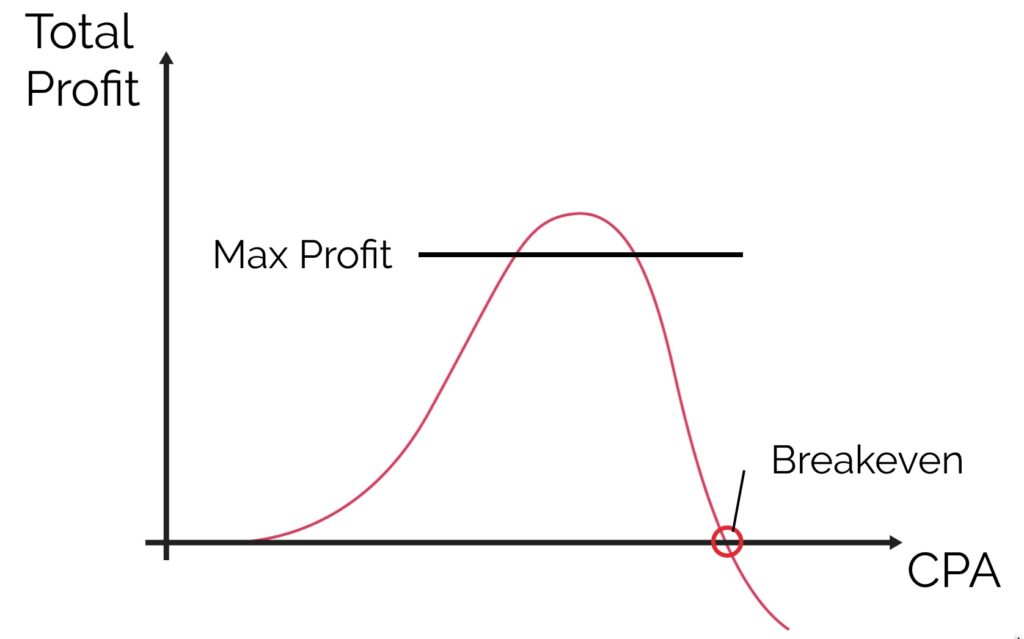
If you can allow the machine to spend a little more than your competitors on each lead, you’ll eventually end up with all the good traffic.
Google Display Ads
Google’s “other” network is the Display Network. Still (!) a mostly untapped resource by most marketers & a huge potential opportunity for your business.
Of course as performance marketers, we want to show ads on sites that lead to real-world outcomes (conversions!) not focus on impressions & cheap clicks. However the Machine doesn’t always target quality sites.
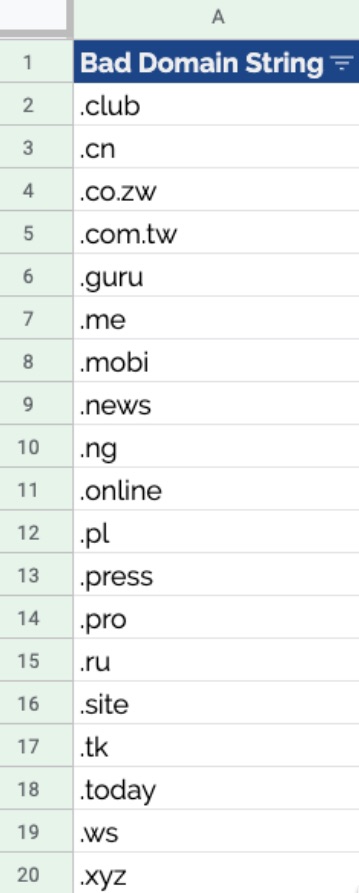
So again we use automation to tackle this problem.
We don’t want to spend thousands or tens of thousands of dollars of client budget to prove (yet again) that those ads on the .xyz or .press site didn’t lead to a great quality of customer. We’ve got stacks of data from millions of dollars of ad spend to prove those assumptions, so we don’t want to start from scratch every time (which the Machine will likely do).
But it’s impossible to stop Google from showing your ads on all .xyz sites unless you know the exact domain name (eg ThisRubbishSite.xyz). Luckily we have a long list of those domains we’ve built up over many years, but new ones are added all the time.
The solution? Another Google Script that digs through the reports every single day & every time it finds a domain containing a phrase we’ve specified (the above is a tiny subset) it blocks that site for every campaign for that client AND adds it to the master list stored in the cloud.
So as soon as a new site gets a single click, we can block it & stop wasting thousands of dollars. For every client.
Potential Negative Keywords
A similar script trawls through the list of search queries every day for search & shopping campaigns looking for new words it’s never seen before.
If the results are terrible, it can block those automatically for ever more. If they’re less than conclusive it’ll flag them for review by a team member to make a subjective call.
So there isn’t a single ‘go to’ killer campaign. Maybe one day the Machine really will be better at optimising your account than a human. Until then the idea is to automate as much as possible, have useful information brought to account managers before they even know they need it, alert them when to look at it & continue to remove the waste.
Hopefully you can use these ideas in your Google account & save a small fortune in the process.
We know—that was a lot. And just like at the Traffic & Conversion Summit, we’re going to leave you with one piece of advice.
Choose the home run strategy that makes the most sense for where you want to take your business in 2020 and focus your efforts on it. Then, let the rest act as a guiding light while you move forward with your new strategy.
Happy New Year!
(NOTE: Need a helping hand with your digital marketing efforts? Or maybe you just want proven, actionable marketing tools, tactics, and templates to implement in your business? Check out the latest deal from DigitalMarketer, and you will be on your way to helping your business grow.)
The post 13 Digital Marketing Experts Share Their Marketing Home Run of 2019 appeared first on DigitalMarketer.
